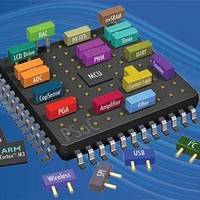CY8C3866AXI-040 Cypress Semiconductor Corp, CY8C3866AXI-040 Datasheet - Page 17

CY8C3866AXI-040
Manufacturer Part Number
CY8C3866AXI-040
Description
PSOC 3 TQFP
Manufacturer
Cypress Semiconductor Corp
Series
PSOC™ 3 CY8C38xxr
Datasheet
1.CY8C3865LTI-058.pdf
(129 pages)
Specifications of CY8C3866AXI-040
Package / Case
*
Voltage - Supply (vcc/vdd)
1.71 V ~ 5.5 V
Operating Temperature
-40°C ~ 85°C
Speed
67MHz
Number Of I /o
62
Eeprom Size
2K x 8
Core Processor
8051
Program Memory Type
FLASH
Ram Size
8K x 8
Program Memory Size
64KB (64K x 8)
Data Converters
A/D 2x20b, D/A 4x8b
Oscillator Type
Internal
Peripherals
CapSense, DMA, LCD, POR, PWM, WDT
Connectivity
CAN, EBI/EMI, I²C, LIN, SPI, UART/USART, USB
Core Size
8-Bit
Processor Series
CY8C38
Core
8051
Data Bus Width
32 bit
Data Ram Size
8 KB
Interface Type
I2C, SPI, UART, USB
Maximum Clock Frequency
67 MHz
Number Of Programmable I/os
28 to 72
Number Of Timers
4
Operating Supply Voltage
0.5 V to 5.5 V
Maximum Operating Temperature
+ 85 C
Mounting Style
SMD/SMT
Controller Family/series
(8051) PSOC 3
No. Of I/o's
62
Eeprom Memory Size
2KB
Ram Memory Size
8KB
Cpu Speed
67MHz
Lead Free Status / RoHS Status
Lead free / RoHS Compliant
Lead Free Status / RoHS Status
Lead free / RoHS Compliant
Available stocks
Company
Part Number
Manufacturer
Quantity
Price
Company:
Part Number:
CY8C3866AXI-040
Manufacturer:
Cypress Semiconductor
Quantity:
135
Company:
Part Number:
CY8C3866AXI-040
Manufacturer:
NXP
Quantity:
112
Company:
Part Number:
CY8C3866AXI-040
Manufacturer:
Cypress Semiconductor Corp
Quantity:
10 000
Part Number:
CY8C3866AXI-040
Manufacturer:
CYPRESS/赛普拉斯
Quantity:
20 000
Company:
Part Number:
CY8C3866AXI-040ES2
Manufacturer:
CYPRESS
Quantity:
153
4.4.4.2 Auto Repeat DMA
Auto repeat DMA is typically used when a static pattern is
repetitively read from system memory and written to a peripheral.
This is done with a single TD that chains to itself.
4.4.4.3 Ping Pong DMA
A ping pong DMA case uses double buffering to allow one buffer
to be filled by one client while another client is consuming the
data previously received in the other buffer. In its simplest form,
this is done by chaining two TDs together so that each TD calls
the opposite TD when complete.
4.4.4.4 Circular DMA
Circular DMA is similar to ping pong DMA except it contains more
than two buffers. In this case there are multiple TDs; after the last
TD is complete it chains back to the first TD.
4.4.4.5 Scatter Gather DMA
In the case of scatter gather DMA, there are multiple
noncontiguous sources or destinations that are required to
effectively carry out an overall DMA transaction. For example, a
packet may need to be transmitted off of the device and the
packet elements, including the header, payload, and trailer, exist
in various noncontiguous locations in memory. Scatter gather
DMA allows the segments to be concatenated together by using
multiple TDs in a chain. The chain gathers the data from the
multiple locations. A similar concept applies for the reception of
data onto the device. Certain parts of the received data may need
to be scattered to various locations in memory for software
processing convenience. Each TD in the chain specifies the
location for each discrete element in the chain.
4.4.4.6 Packet Queuing DMA
Packet queuing DMA is similar to scatter gather DMA but
specifically refers to packet protocols. With these protocols,
there may be separate configuration, data, and status phases
associated with sending or receiving a packet.
For instance, to transmit a packet, a memory mapped
configuration register can be written inside a peripheral,
specifying the overall length of the ensuing data phase. The CPU
can set up this configuration information anywhere in system
memory and copy it with a simple TD to the peripheral. After the
configuration phase, a data phase TD (or a series of data phase
TDs) can begin (potentially using scatter gather). When the data
Document Number: 001-11729 Rev. *R
phase TD(s) finish, a status phase TD can be invoked that reads
some memory mapped status information from the peripheral
and copies it to a location in system memory specified by the
CPU for later inspection. Multiple sets of configuration, data, and
status phase ‘subchains’ can be strung together to create larger
chains that transmit multiple packets in this way. A similar
concept exists in the opposite direction to receive the packets.
4.4.4.7 Nested DMA
One TD may modify another TD, as the TD configuration space
is memory mapped similar to any other peripheral. For example,
a first TD loads a second TD’s configuration and then calls the
second TD. The second TD moves data as required by the
application. When complete, the second TD calls the first TD,
which again updates the second TD’s configuration. This
process repeats as often as necessary.
4.5 Interrupt Controller
The interrupt controller provides a mechanism for hardware
resources to change program execution to a new address,
independent of the current task being executed by the main
code. The interrupt controller provides enhanced features not
found on original 8051 interrupt controllers:
Figure 4-2
interrupt triggered.
structure and priority polling.
Thirty-two interrupt vectors
Jumps directly to ISR anywhere in code space with dynamic
vector addresses
Multiple sources for each vector
Flexible interrupt to vector matching
Each interrupt vector is independently enabled or disabled
Each interrupt can be dynamically assigned one of eight
priorities
Eight level nestable interrupts
Multiple I/O interrupt vectors
Software can send interrupts
Software can clear pending interrupts
on page 18 represents typical flow of events when an
Figure 4-3
PSoC
®
on page 19 shows the interrupt
3: CY8C38 Family
Data Sheet
Page 17 of 129
[+] Feedback












